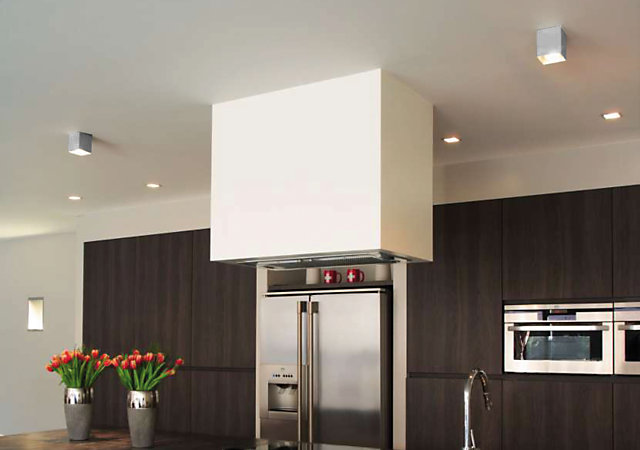Ceiling lights, Ceiling luminaires are attached to the ceiling and are therefore space-saving. In bathrooms and hallways, for instance, they can provide for ambient lighting or illuminate defined areas such as tables, cupboards and pictures with highly focused light. Ceiling lights typically emit their light downwards, onto the wall or in all directions.

Downward light emission
Ceiling luminaires which emit their light downwards supply directed
zone lighting and thereby brightly illuminate defined areas.
Typical areas of use: this type of ceiling luminaire is used to provide for zone lighting above a coffee table in the living room, a dining table in the dining room or a worktop in the kitchen.
Standard version: this type of luminaire is directly attached to the ceiling and has a reflector or a shade with a downwards pointing opening.
The light11 recommendation
- For bright zone lighting on coffee tables, dining tables and kitchen worktops, the light emitted by the ceiling luminaire must be strongly focused.
- The illuminant as well as the bright components of the luminaire, such as opal glass, should not be directly visible when you are in a sitting position as this would be blinding
- In dining rooms and living rooms, it is recommended to use a light fixture with a dimmer as this allows for an individual adjustment of the lighting mood.

Light emission onto the wall
Ceiling luminaires which emit their light onto the walls supply directed zone lighting and thereby brightly illuminate defined areas.
Typical areas of use: this type of ceiling light is used as zone lighting to illuminate
cupboards, shelves
or paintings and pictures.
Standard version: this type of luminaire is attached directly to the ceiling and has a reflector or shade with a sideways pointing opening.
The light11 recommendation
- When illuminating cupboards and shelves, the luminaire should be installed closely enough for no shadows to be cast onto the cupboard or shelf by the persons using them. At the same time, it should be sufficiently far away for the shelves to be illuminated as fully as possible. As a rule of thumb we can say that the distance between the luminaire and the cupboard or shelf should equate to about a third of the ceiling height. For particularly wide cupboards and shelves, multiple luminaires might be required. They are installed at a distance from one another which equates to about half the ceiling height.
- It is only easy to find the things stored lower down when the entire cupboard or shelf is evenly illuminated from top to bottom.
- If you want to illuminate paintings or pictures, the entire wall, including the painting/picture, should be evenly illuminated from top to bottom. Even museums use this technique to illuminate their objets d'art. One particular advantage is that you can exchange the pictures without having to replace the luminaire.
- It is generally not recommended to use picture lights as they usually only brightly illuminate the top section of the picture. This way, the viewer does not see a natural reproduction of the work. Additionally, luminaires directly attached to the painting/picture make it become yellow more quickly and dry out due to the strong heat development.

Light emission in all directions
Ceiling luminaires which emit light in all directions provide for diffuse ambient lighting.
Typical areas of use: this type of ceiling light is used to ensure
ambient lighting in bathroomsand hallways.
Standard version: this type of light is attached directly to the ceiling and has a diffuser which scatters the light in all directions.
The light11 recommendation
- Ceiling luminaires installed in bathrooms should be splash-proof and should comply with the safety regulations in line with the European standard EN 60598.
- If you choose an opal glass luminaire, please ensure that is evenly illuminated.
